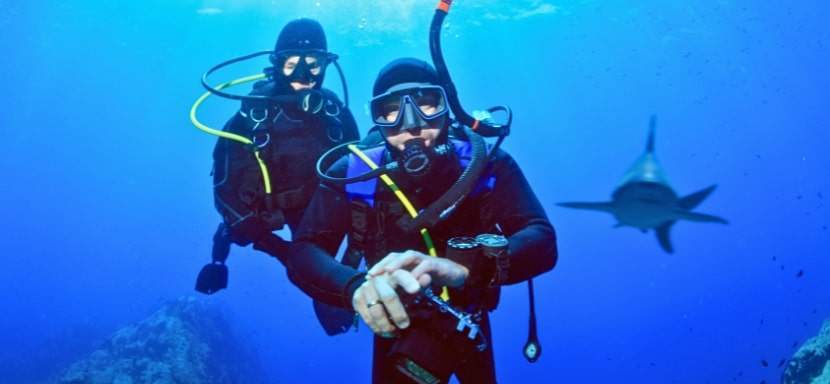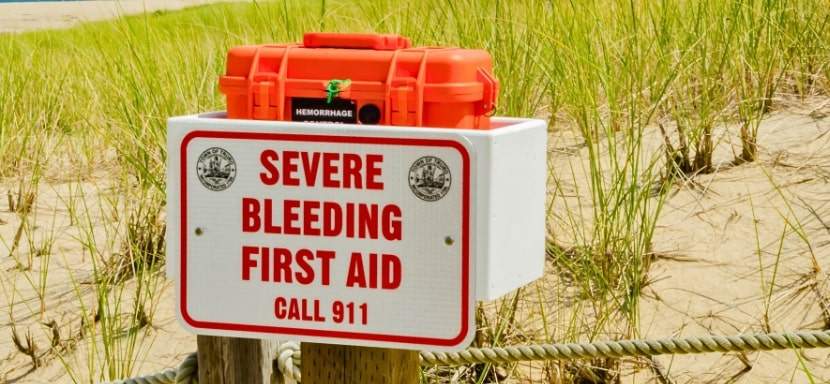How to Survive a Shark Attack

The Ultimate Guide to Shark Attack Survival
In the United States, among beachgoers, the likelihood of experiencing a shark attack is a mere 1 in 11.5 million. Furthermore, the probability of a fatal shark encounter plummets to less than 1 in 264.1 million. The bad news is shark attacks are steadily on the rise.
With warmer climates, sharks are starting to head farther north due to warmer waters. Warmer waters also bring more people to the beach, where swimming in the ocean is the main attraction. The combination of these two is just one of the reasons shark attacks are on the rise.
If you find yourself in a shark-attack survival situation, the best thing to do is adapt to the rules of the ocean rather than to your basic instincts.
Understanding the Reality of Shark Encounters
Sharks have roamed the world’s oceans for millions of years, essential to the marine ecosystem. Over 500 species’ behavior, diet, and habitats vary significantly. Contrary to the menacing image often depicted in movies and sensational media stories, sharks do not seek out humans as prey. Most shark species are naturally cautious of humans and would rather avoid contact.
The rarity of shark attacks is evidenced by statistics, which show that the likelihood of being attacked by a shark is about 1 in 11.5 million, reported by The International Shark Attack File (ISAF). To put this into perspective, you’re more likely to be struck by lightning or injured in a car accident than to be bitten by a shark.
Most sharks are naturally cautious and reluctant to approach humans, and incidents often occur due to mistaken identity or curiosity rather than predatory aggression.
Importance of Knowledge and Preparedness
Knowledge and preparedness are vital to reducing fear and increasing safety in shark-inhabited waters. Educating oneself about shark behavior, understanding the conditions that might increase the likelihood of an encounter, and learning how to respond if one does occur can make a significant difference.
Knowledge empowers individuals to make informed decisions, such as avoiding swimming at dawn or dusk when sharks are more active, staying in groups, and avoiding areas known for shark activity. Preparedness involves knowing these safety tips and how to react in the unlikely event of a shark encounter. This proactive approach can drastically reduce the risk and severity of shark interactions.
Shark Behavior
Understanding the behavior of sharks is crucial for anyone looking to navigate the waters they inhabit safely.
By separating fact from fiction and gaining insight into the reasons behind shark attacks, we can adopt more informed and respectful approaches to sharing the ocean with these ancient creatures.
Dangerous Waters
There are 12 dangerous species of sharks. However, only three species, the great white, bull, and tiger sharks are responsible for most attacks on humans out of the 375+ total shark species in the world. The good news is humans are not their preferred food choice.
Your best defense against a shark attack is to avoid dangerous waters. You should avoid swimming in areas known for shark sightings—sharks like to hunt and feed around harbor entrances and river mouths. Also, don’t swim later in the evening or earlier in the morning.
You also want to avoid fishing boats tossing dead fish and chum in the water. A shark’s nose is susceptible, and blood in the water is like a dinner bell to them.
Common Myths vs. Facts about Sharks
For years, sharks have been the subject of myths and misconceptions, often painted as monstrous villains of the deep. However, understanding the truth behind these myths can help demystify these creatures and promote a more respectful coexistence.
Myth: Sharks have a taste for human flesh.
- Fact: Sharks generally do not prefer humans as prey. Most shark attacks on humans are believed to be cases of mistaken identity, with the shark mistaking a human for its usual prey, such as seals or sea lions.
Myth: Sharks are mindless killers.
- Fact: Sharks are highly evolved predators with complex behaviors. They are not mindless killing machines but rather play a crucial role in maintaining the health of marine ecosystems by managing the population of their prey.
Myth: If you see a shark, an attack is imminent.
- Fact: Sharks are often curious and may approach humans out of curiosity rather than aggression. Most of these encounters end without incident.
Did You Know?
Sharks attack more men than women.
Why Sharks Attack Humans
The interactions between sharks and humans have long been a topic of fascination and fear, mainly due to the rare but often dramatized occurrences of shark attacks. Understanding the reasons behind these attacks is crucial for both reducing the chances of such encounters and demystifying the behavior of these ancient marine predators.
- Mistaken Identity: In murky waters or under certain conditions, a swimming human can resemble a shark’s natural prey, leading to an accidental attack.
- Defense: Sharks may attack humans if threatened, especially cornered or surprised.
- Curiosity: Sharks, particularly juvenile ones, explore their environment by biting to learn about objects in the water, which can, unfortunately, include humans.
Shark Attack Techniques
Shark attack methodologies exhibit a remarkable diversity but can fundamentally be categorized into three distinct groups based on their approach and behavior during the encounter:
Hit-and-Run Attacks
- Most common shark attack type.
- It involves a single bite; the shark does not return.
- It likely occurs due to mistaken identity, with the shark leaving upon realizing the mistake.
Bump-and-Bite Attacks
- It begins with the shark bumping the victim.
- The shark returns to inflict additional bites.
- Indicates a more deliberate assessment by the shark.
Sneak Attacks
- It is characterized by sudden, aggressive biting without prior warning.
- The shark may continue attacking after the initial bite.
- Responsible for the most severe injuries and fatalities.
Different Types of Shark Behavior
Sharks exhibit a range of behaviors that are crucial for their survival in the wild. Understanding these behaviors enriches our knowledge of shark biology and helps minimize negative interactions between sharks and humans.
- Feeding Behavior: This is when a shark is actively hunting for food. Sharks may be more aggressive during feeding times or when food is scarce.
- Social Behavior: Some sharks exhibit complex social behaviors, including group hierarchies.
- Migratory Behavior: Many sharks undergo long migrations to breed or follow prey populations. Understanding these patterns can help predict shark presence in certain areas.
- Territorial Behavior: Sharks, like many animals, can be territorial. Intruding into a shark’s territory can provoke an aggressive response.
- Investigative Behavior: Sharks are known to gently bite objects to explore their environment, which can, unfortunately, lead to accidental human injuries.
Who’s The Boss?
If the shark is dead set on attacking you, the only thing you can do is fight back. The one thing sharks respect is size and power. If you find yourself in this situation, you must know you have nothing to lose. So fight like your life depends on it (because it does). Be ultra-aggressive and give the shark everything you have.
Aim for the most sensitive spots on the shark. Hit and kick at the nose as hard as you can. Let the attacker know you’re not going down without a fight. You may surprise it; he’ll turn his tail and swim away. If you can, poke your fingers or thumb in its eye as hard as possible. This may confuse the shark and make you realize you shouldn’t be messed with.

Preventing Shark Encounters
Preventing shark encounters is critical to ensuring safety for individuals enjoying oceanic activities. While shark attacks are rare, preventive measures can further minimize the risk.
Understanding and implementing strategies such as choosing safe swimming times and areas, avoiding activities that attract sharks, and considering visibility and environmental factors can significantly reduce the likelihood of encountering sharks.
Choosing Safe Swimming Times and Areas
- Swim during safer times: Avoid early morning and late evening, as sharks are more active during these periods.
- Select monitored beaches: Prefer beaches with lifeguards and shark monitoring programs.
- Stay in clear, shallow water: This reduces the chance of surprise encounters.
Avoiding Activities That Attract Sharks
- Avoid swimming with wounds: Sharks can detect blood from long distances.
- Refrain from wearing shiny objects: Jewelry can mimic the sheen of fish scales and attract sharks.
- Steer clear of fishing areas: Swimming near active fishermen can increase the risk due to bait and caught fish attracting sharks.
The Role of Visibility and Environmental Factors
- Maintain high visibility: Avoid murky waters where sharks might mistake you for their usual prey due to poor visibility.
- Be cautious around river mouths: These areas can attract sharks due to the presence of fish.
- Understand local conditions: Awareness of the environmental factors that may influence shark presence, such as natural prey migrations, can help choose safer swimming locations.
Recognizing the Signs of a Shark in the Water
Recognizing a shark’s presence in the water before an encounter can ensure personal safety during oceanic activities.
Several surface and underwater indicators can signal a shark’s presence, and reactions to a shark sighting to minimize risk are recommended.
Identifying the signs of a shark nearby can provide crucial seconds for a response, potentially preventing an encounter.
Surface Indicators:
- Finned silhouette: The iconic fin cutting through the water’s surface clearly shows a shark.
- Erratic fish movement: Sudden, rapid movements or fish jumping can indicate they are trying to escape a predator.
- Bird activity: Seabirds diving repeatedly in a specific area might feed on baitfish, which could also attract sharks.
Underwater Indicators:
- Shadows or silhouettes: Large moving shadows or distinct silhouettes in the water could be sharks.
- Sudden disappearance of fish: If the small fish suddenly vanishes, it could mean they’re hiding from a predator.
- Unusual sounds: Although less common, hearing thuds or splashes could indicate a shark attacking prey.
How to React to a Shark Sighting
If you spot a shark or suspect one is nearby, staying calm and knowing how to react can significantly reduce the risk of an encounter turning into an attack.
- Stay calm: Panicking can attract the shark and make the situation worse.
- Maintain eye contact: If you’re close enough to make out the shark, try to keep it in sight. Sharks are less likely to attack if they know they’ve been seen.
- Slowly back away: Move towards the shore or your boat, keeping movements smooth and deliberate to avoid splashing.
- Keep yourself vertical: Make yourself appear more prominent and maintain a vertical position in the water.
- Join a group: If you’re not alone, gather together. Sharks are less likely to approach a group.
- Get out of the water: If it’s safe, calmly and quickly leave.
If a Shark Approaches You
If a shark shows interest and approaches you, maintaining composure and knowing how to react can make a significant difference.
Maintaining Composure: What to Do and Not to Do
- Do not panic: Rapid movements or splashing can attract the shark further.
- Keep eye contact: Sharks may be less likely to attack if you’re facing them, as they prefer to ambush.
- Do not turn your back: Always keep the shark in view as you slowly return to safety.
Techniques to Deter a Curious Shark
- Use a firm push: If a shark gets too close, a firm push on the nose can sometimes deter it. However, this should only be a last resort.
- Make yourself big: Try to appear larger by keeping your arms and legs spread if a shark is circling.
Defensive Positions to Adopt in the Water
- Vertical posture: Staying upright can make you appear more prominent and less like typical prey.
- Back against a structure: If near a reef or rock, place your back against it to prevent the shark from circling behind you.
- Group together: If you’re with others, group together to appear as a larger entity to the shark.

During a Shark Attack: Survival Strategies
Knowing how to respond can be crucial for your survival in the unlikely event of a shark attack. While shark encounters are rare and attacks even rarer, being prepared with effective survival strategies can help you defend yourself.
Here are critical approaches to consider if you find yourself in this crucial situation.
Effective Defense Strategies
- Stay calm: Your ability to think clearly and act decisively is crucial. Panic can make the situation worse.
- Defend yourself: If a shark attacks, defend yourself with whatever means necessary. Be assertive and determined in your actions.
Utilizing Available Resources as Weapons
- Use what you have: In the absence of a weapon, use any available objects—snorkels, cameras, or even your fists and feet can serve as defense tools.
- Make precise movements: Aim your strikes to be strong and controlled, avoiding flailing or erratic movements that can further provoke the shark.
The Importance of Targeting Sensitive Areas
- Aim for the nose, eyes, and gills: These are the most sensitive parts of a shark. A strong push or punch to the nose, gouging the eyes, or targeting the gills can make a shark reconsider its attack and possibly retreat.
- Continuous effort: If the shark continues its attack, keep fighting back. Continuous resistance can convince the shark that you’re not worth the trouble.
Additional Tips
- Protect your mid-section and limbs: Use your elbows and knees to shield your torso, and keep your back to any solid surface to protect yourself from multiple angles.
- Don’t play dead: Sharks are scavengers that might bite into something to see if it’s edible. Showing you are alive and capable of fighting back can deter further aggression.
Surviving a shark attack largely depends on staying calm, utilizing whatever defenses are available, and focusing on the shark’s most sensitive areas. These situations are scarce, but preparedness can significantly impact outcomes.
Gentle Giants
The whale shark is the world’s largest living fish and feeds on one of the smallest plankton. They reach a length of 40′ or more and live to be about 70 years old.
After a Shark Attack: Immediate Actions
In the aftermath of a shark attack, quick and effective action is crucial for the victim’s survival and recovery.
Prompt first aid, clear communication for help, and the ability to assess the situation for self-rescue are pivotal steps that can significantly impact the outcome.
First Aid for Shark Bite Injuries
Immediate medical attention is necessary, but before professional help arrives, first aid can make a significant difference:
- To stop the bleeding, Apply direct pressure to the wound with any clean cloth or piece of clothing. If the bleeding is severe and on a limb, applying a tourniquet above the injury site may be necessary to reduce blood loss.
- Keep the victim warm: Shock is a common reaction to a severe injury. Keeping the victim warm and calm can help mitigate the shock’s effects.
- Elevate the injured part: To reduce bleeding, elevate the wounded area above the level of the heart.
- Avoid moving the victim unnecessarily: If you must move them, try to stabilize the injured part to prevent further damage.
How to Call for Help Effectively
Getting help quickly is critical. Here’s how to call for help effectively:
- Use a whistle or flare if available: These can attract attention from far away.
- Send a clear signal for help: If you’re with a group, send someone to get help while others attend to the victim.
- Use a cell phone if within range: Be concise and clear when explaining the situation, providing specific details about your location and the nature of the injuries.
Assessing the Situation and Self-Rescue Methods
Evaluating your immediate surroundings and knowing how to get yourself or the victim to safety is vital:
- Look for an exit: Identify the quickest and safest way to get out of the water and onto shore or a boat.
- Stay calm and focused. Panic can cloud judgment. Analyze the situation logically to decide on the best course of action.
- Use available resources: Use anything that can help support the injured person’s weight or signal for assistance.

Medical Treatment and Recovery
Following a shark attack, the journey towards healing and recovery encompasses both physical and psychological aspects.
Immediate and comprehensive medical treatment is crucial for physical injuries while recognizing and addressing the psychological impact is vital for overall recovery. Rehabilitation plays a pivotal role in helping survivors return to their daily activities.
Types of Shark Bite Injuries and Treatments
Shark bite injuries can range from minor lacerations to severe tissue damage, and the treatment varies accordingly:
- Lacerations: Minor cuts may require cleaning, disinfection, and stitches to promote healing.
- Puncture wounds: These deeper wounds might need surgical intervention to clean the damaged tissues thoroughly and reduce the risk of infection.
- Tissue loss: In cases of significant tissue loss, reconstructive surgery or skin grafts may be necessary to cover the wound and support the healing process.
- Amputations: Severe attacks may result in the loss of a limb, necessitating emergency surgery, followed by long-term physical therapy and possibly the fitting of a prosthetic.
The Psychological Impact of a Shark Attack
Survivors of shark attacks often face psychological challenges such as:
- Post-Traumatic Stress Disorder (PTSD): Recurring memories, nightmares, and severe anxiety related to the incident.
- Phobias: An intense fear of water or sharks that can inhibit daily functioning or prevent survivors from engaging in activities they once enjoyed.
- Depression and Anxiety: Feelings of sadness, hopelessness, or excessive worries about the future and recovery.
Addressing these psychological impacts through counseling, therapy, and support groups is essential for comprehensive recovery.
Recovery Process and Rehabilitation
The path to recovery and rehabilitation requires time, patience, and various resources:
- Physical therapy: To regain strength, mobility, and functionality, primarily if the attack resulted in limb loss or significant tissue damage.
- Occupational therapy: Helps survivors adapt to physical limitations and regain independence in daily activities.
- Support networks: Engaging with support groups and networks can provide emotional support and practical advice from others who have experienced similar trauma.
- Gradual exposure: For those developing phobias, carefully guided exposure to water or swimming can be part of therapy, helping them to overcome fear in a controlled environment.
Recovery from a shark attack is a multifaceted process that addresses physical injuries, psychological effects, and the survivor’s overall well-being. With the proper medical care, psychological support, and rehabilitation services, survivors can navigate the complex journey toward healing and reclaiming their lives.
Educational and Preventive Measures
Addressing the fear and potential danger of shark attacks involves understanding the risks and adopting a comprehensive approach to education, conservation, and prevention.
Through informed perspectives, conservation efforts, and targeted educational campaigns, communities can work towards minimizing shark attacks while fostering a respectful coexistence with these ancient marine predators.
Shark Attack Statistics and Their Interpretation
- Understanding the odds: Shark attack statistics reveal that such incidents are exceedingly rare, with the likelihood of being attacked by a shark being far less than many everyday risks. Interpreting these statistics correctly can help reduce irrational fears and promote safer behaviors in shark-inhabited waters.
- Species-specific risk: Most shark attacks are attributed to a few species. Educating the public about these species, their habitats, and behaviors can further refine risk assessment and guide safer interaction with the marine environment.
Role of Shark Conservation in Reducing Attacks
- Healthy ecosystems: Sharks play a crucial role in maintaining the health and balance of marine ecosystems. Conservation efforts to protect shark populations help ensure stable marine environments, indirectly reducing the likelihood of shark-human encounters.
- Targeted conservation: Protecting habitats critical to sharks, such as breeding and feeding grounds, can also minimize interactions between sharks and humans by maintaining natural barriers and distances between them.
Educational Programs and Safety Campaigns
- Public education: Programs designed to inform the public about shark behavior, the importance of sharks to marine ecosystems, and practical safety tips can empower individuals to make informed decisions when entering the water.
- Safety campaigns: Campaigns that focus on specific actions, such as swimming in groups, avoiding swimming at dawn or dusk, and not entering the water with open wounds, provide clear guidelines to reduce the risk of shark encounters.
- Community involvement: Engaging local communities, especially in coastal areas, in shark conservation and education efforts can foster a culture of awareness and respect for marine life. Community-led initiatives can also adapt messages and strategies to fit local contexts and needs.
Shark Safety Equipment and Technology
Safety equipment and technological advancements have emerged as critical components in pursuing safer human interactions with sharks.
These innovations range from deterrent devices designed to keep sharks at bay to sophisticated detection systems that warn of a shark’s presence.
Understanding the pros and cons of these technologies and evaluating their effectiveness is essential for anyone looking to minimize the risks of shark encounters.
Shark Deterrent Devices: Pros and Cons
- Electrical deterrents: These devices emit an uncomfortable electrical field that could keep sharks away from the wearer.
- The pros include a relatively high success rate in deterring certain species.
- The cons involve the devices’ limited effective range and the necessity to be fully charged to work.
- Magnetic and acoustic deterrents: Utilize magnets or sound waves to disrupt the sensory receptors of sharks.
- Pros are their passive nature, requiring no power source.
- Cons include inconsistent results across different shark species and situations.
Innovations in Shark Detection and Avoidance
- Aerial drones: Provide real-time surveillance of coastal waters, identifying shark movements close to swimming areas
- Pros include a broad coverage area and the ability to relay immediate warnings.
- Cons involve the need for constant monitoring and potential privacy concerns.
- Sonar technology: Installed at beaches, these systems detect sharks’ shape and movement patterns.
- Pros are their continuous monitoring capability and early warning potential.
- Cons include high installation and maintenance costs.
Evaluating the Effectiveness of Safety Gear
- Research and testing: Ongoing scientific research is crucial for assessing the real-world effectiveness of shark deterrents and detection systems. Studies often involve simulated attacks in controlled environments or field testing in shark-inhabited waters.
- User feedback: Collecting and analyzing feedback from individuals who have used shark safety gear provides valuable insights into its practicality, durability, and overall performance.
- Environmental impact: It’s also important to consider these technologies’ ecological footprints, ensuring they do not harm marine life or disrupt the ecosystem.
The development and implementation of shark safety equipment and technology represent promising strides toward reducing shark-human conflicts.
However, the effectiveness of these tools can vary, and they should be used as part of a broader approach to ocean safety that includes awareness, education, and respecting marine wildlife habitats.
As technology evolves, so will our ability to safely coexist with sharks, protecting humans and marine life.
Personal Stories of Surviving a Shark Attack
The personal stories of individuals who have survived shark attacks provide not only a testament to human resilience and courage but also invaluable insights and lessons that can benefit all who venture into the ocean.
Through these accounts, survivors share the details of their encounters and the knowledge they gained, offering advice that can help others minimize risks and respond effectively in dangerous situations.
Accounts from Shark Attack Survivors
- Many survivors recount a sudden sense of shock and disbelief during the initial moments of the attack, followed by an automatic fight for survival. These stories often highlight the unpredictability of shark encounters and the rapid progression from tranquility to life-threatening danger.
- Narratives frequently describe the immediate aftermath of the attack, including self-rescue efforts, the critical role of bystanders in providing first aid, and the rush to secure medical care, underscoring the importance of emergency preparedness and response.
Lessons Learned and Advice for Swimmers
- Stay calm and defend: Survivors often stress the importance of staying calm and using defensive measures against the shark, such as targeting sensitive areas like the eyes and gills. Their experiences underline that panic can exacerbate the situation, while resistance might deter further aggression from the shark.
- Swim in groups: Many advocate swimming in groups, as sharks are likelier to approach individuals alone. The presence of others can not only deter a shark but also ensure immediate help in case of an emergency.
- Be aware of your surroundings: Survivors advise paying attention to the marine environment, noting any unusual wildlife behavior that might indicate a shark’s presence, and adhering to local advisories about shark activity.
- Respect the ocean: A common theme among survivor stories is a renewed respect for the sea and its inhabitants. Survivors often express a deeper understanding of the risks of entering the marine environment and the importance of coexisting with its predators.
FAQs on Shark Behavior and Attack Prevention
Why do sharks attack humans?
Sharks typically do not target humans as prey. Most shark attacks are attributed to mistaken identity, curiosity, or defensive behavior. In murky waters or under certain conditions, a human might be mistaken for a shark’s natural prey, like a seal.
Can sharks sense fear in humans?
There is no scientific evidence to suggest that sharks can sense fear. However, erratic movements or splashing might attract a curious or investigating shark, so staying calm and minimizing movement is advised if a shark is spotted.
What should I do if I see a shark while swimming?
If you spot a shark, remain calm and slowly back away without making sudden movements. Try to keep the shark in sight, but do not block its path or corner it. If you’re near the shore or a boat, calmly but steadily move towards safety.
Are specific colors or patterns more likely to attract sharks?
How can I reduce the risk of a shark attack?
- Swim in groups, as sharks are more likely to approach solitary individuals.
- Avoid swimming at dawn and dusk when sharks are most active.
- Stay close to shore and avoid swimming in areas where sharks are known to frequent, such as near drop-offs.
- Do not enter the water if bleeding from wounds, as sharks can detect blood.
Is it safe to swim in waters where sharks have been sighted?
While sharks’ presence can be alarming, most are not interested in humans. Pay attention to local advisories and lifeguard warnings. If sharks have been sighted, staying out of the water is advisable until officials deem it safe.
What are the best ways to defend myself during a shark attack?
- Focus on defending yourself by targeting the shark’s sensitive areas, such as the eyes, nose, and gills.
- Use any available object as a weapon, or use your fists and feet if necessary.
- Try to maintain a vertical position to avoid appearing like typical prey.
Keeping Safe with Sharks: Living Together in Peace
Sharks are essential to the ocean, and attacks on humans are sporadic.
This guide has shown how to stay safe around sharks and why we must protect them. Knowing what to do if you see a shark and how to avoid an attack can help you feel more secure in the water. It’s also essential to take care of the ocean and its sharks. When we help save sharks and their homes, we make the ocean a better place for all creatures.
Remember to share the ocean respectfully and kindly so people and sharks can be safe and healthy.
Crazy Shark Attack Facts
Sharks have a mystery about them. Movies like Jaws and documentaries such as Discovery Channel’s Shark Week have some people scared to step one foot into the ocean.
Here are a few facts about these dead-eye cold killing machines.
- For every human killed by a shark, humans kill approximately two million sharks.
- Most shark attacks occur less than 100 feet from the shore, mainly around famous beaches in North America (especially Florida and Hawaii), Australia, and South Africa.
- Sharks are not fans of what humans taste like.
- The Great White Shark is responsible for the most attacks on humans.
- New Smyrna Beach, Florida, is considered to be the shark attack capital of the world.
- A shark has many rows of teeth commonly falling out, and new ones take the old ones’ place.
- Sharks appeared on the scene approximately 400 million years ago, about 200 million years before the dinosaurs.
- Injuries from shark bites can be minor to life-threatening. Large amounts of bleeding and massive tissue loss most often carry a worse prognosis.
- You are more likely to die from texting and driving than being killed by a shark.
- Since 1907, 201 out of 220 significant white attacks have occurred when the victim was less than six feet from the surface.
- Some sharks can live up to 70 years or more.
- Sharks do not have bones; their skeletons are made of cartilage, which is lighter and more flexible.
- Sharks can sense a drop of blood in 25 gallons of water and detect it from over a quarter of a mile away.
- Not all sharks are significant; the dwarf lantern shark is the smallest known shark species, small enough to fit in the palm of your hand.
- Sharks have a sixth sense that helps them navigate and hunt using the earth’s magnetic field, thanks to particular organs called the ampullae of Lorenzini.

More Wild Frontier Scenarios
How to Survive a Mountain Lion Attack
Learn how to survive a mountain lion attack with practical steps to protect yourself and stay safe in. Surviving a…
How to Survive a Raccoon Attack
It’s a quiet evening, the moon is out, and maybe you’re taking out the trash or just enjoying a night…
How to Survive a Wild Boar Attack
Encountering a wild boar is like meeting your ex at a grocery store—unexpected, unnerving, and, in most…
How to Survive a Swarm of Bees
Surviving a bee swarm might sound like a scene out of a movie, but it’s a real concern for those who…
How to Survive a Skunk Spray
Getting sprayed by a skunk is a smelly situation that no one wants to find themselves in. However, if…
Recent Survival Posts
How to Survive a Layoff
Layoffs feel personal—even when they’re not. One day, you’re responding to Slack messages and forwarding…
How to Survive a Drug Test
I never imagined I’d be so emotionally invested in a paper cup. But there I was, standing under the fluorescent…
How to Survive an Interrogation
If you’ve ever been caught in the crosshairs of an overly enthusiastic mall cop or stared down by someone…
How to Survive a Nightclub Shooting
Nightclubs pulse with life—lights flashing, music pounding, bodies packed tight on the dance floor. It’s a place to…
How to Survive a Bachelor Party
A bachelor party is a delicate mix of celebration, chaos, and questionable decision-making, wrapped…
More Air, Wild Frontier Survival Scenarios

How to Survive a Raccoon Attack
It’s a quiet evening, the moon is out, and maybe you're taking out the trash or enjoying a night on your porch. And suddenly, out of the shadows, bam! There it is—those black-ringed eyes glowing at you like some creature from a raccoon version of “The Shining.” If...

How to Survive a Wild Boar Attack
Encountering a wild boar is like meeting your ex at a grocery store—unexpected, unnerving, and, in most cases, best avoided. Yet, wild boars aren't interested in your baggage or drama; they're just trying to mind their own business—unless they think you're a threat....

How to Survive a Swarm of Bees
Surviving a bee swarm might sound like a scene out of a movie, but it's a genuine concern for those who love the outdoors. Imagine this: you're hiking on a beautiful sunny day, enjoying the tranquility of nature, when suddenly you hear a low buzzing sound that...

How to Survive a Skunk Spray
Getting sprayed by a skunk is a smelly situation that no one wants to find themselves in. However, if you do end up as a target of this defensive mechanism, knowing how to handle the aftermath can make a huge difference. Let's explore some practical steps and advice...

How to Survive a Bear Attack
Bear Attack Survival Tips and Strategies Though rare, bear attacks can occur because bears remember food locations for years and may silently track humans to assess threats or follow scents. Surviving a bear attack involves more than just reacting during an encounter;...
More Survival Scenarios

How to Survive a Layoff
When the Floor Falls Out: The Reality of a Layoff Layoffs feel personal—even when they're not. One day, you're responding to Slack messages and forwarding emails. Next, you're staring at your monitor as it logs you out... for good. Whether it's a restructuring, a...

How to Survive a Drug Test
The Cup, The Room, The Truth I never imagined I’d be so emotionally invested in a paper cup. But there I was, standing under the fluorescent hum of a strip-mall clinic, trying to recall the last time I ate a poppy seed bagel. That’s the thing about drug tests—they...

How to Survive an Interrogation
If you've ever been caught in the crosshairs of an overly enthusiastic mall cop or stared down by someone in a uniform with a clipboard and a glare, you’ve felt it — the chilly fingers of interrogation anxiety. And while most of us imagine interrogation scenes as...

How to Survive a Nightclub Shooting
Nightclubs pulse with life—lights flashing, music pounding, bodies packed tight on the dance floor. It’s a place to escape, feel the rhythm, and lose yourself in the crowd. But that same energy can turn deadly in seconds, transforming a night of fun into one of the...

How to Survive a Bachelor Party
A bachelor party is a delicate mix of celebration, chaos, and questionable decision-making, wrapped in the noble intention of sending the groom off into married life with a night he’ll (hopefully) remember. It’s a ritual as old as time—well, as old as men deciding...

How to Survive Your First Time at the Gym
Walking into a gym for the first time can feel like stepping into an alien world. The machines hum with purpose, the regulars move confidently, and you’re left standing there, clutching your water bottle, wondering whether you’re in the right place—or on the right...

How to Survive a Worldwide Communications Breakdown
Imagine waking up to silence. Your phone doesn’t buzz, your email won’t load, and even your local radio station crackles with static. A worldwide communications breakdown has hit. What next? For many, this doomsday scenario may sound like the opening lines of a...

How to Survive a Flash Flood While Driving
Surviving a flash flood while driving requires quick thinking, calmness, and a solid plan to ensure your safety. Preparation can make all the difference between a close call and a catastrophe in emergencies like this. This guide provides practical advice to protect...

How to Build an Emergency Kit
Emergencies don’t knock politely at the door. They barge in, uninvited, like a distant relative with a penchant for drama, turning your world upside down without warning. Whether it’s a power outage, a natural disaster, or an unexpected evacuation, the key to staying...

How to Protect Yourself From Insects in the Wild
There’s nothing like being out in the wild—birdsong echoing through the trees, the fresh scent of earth, and a deep sense of peace that makes you think, “Ah, this is what life is about.” But then comes the buzzing. Mosquitoes, ticks, and flies swoop in like uninvited...
